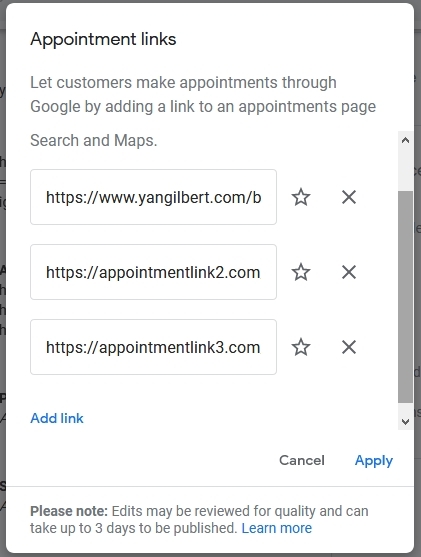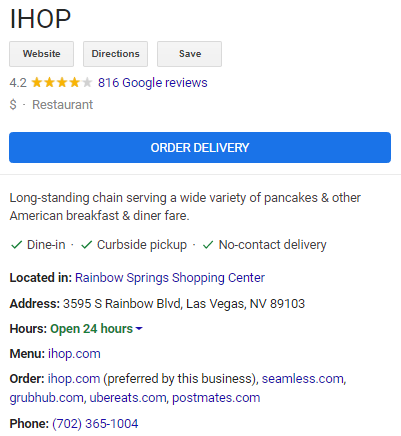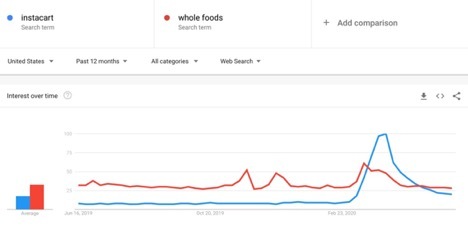Damian Rollison | Jul 13, 2020 8:00:00 AM
6 Min Read
In this week’s update, read about Uber’s acquisition of Postmates and the growth of online delivery; multiple appointment links in GMB; new delivery management options in GMB for restaurants; the impact of COVID-19 as measured by Google Trends; the launch of Walmart’s subscription service; and telehealth as a new fixture in healthcare.
The announcement that Uber has acquired delivery rival Postmates for $2.65 billion was widely reported last week. Uber plans to continue running Postmates as a separate brand, while introducing some operational efficiencies, such as enabling drivers to deliver for both Uber Eats and Postmates. Uber had formerly attempted to acquire GrubHub, which was ultimately purchased by European delivery firm Just Eat Takeaway for $7.3 billion.
Such moves in the delivery space reflect the growth in that sector before and especially after the pandemic began. Uber Eats, for example, grew 52% in the last quarter amidst declines in Uber’s ride sharing business.
In the parallel space of grocery delivery, a new report from Brick Meets Click and Mercatus shows growth in online grocery orders continuing into June. In fact, June online grocery sales hit a record of $7.2 billion in the U.S., up 9% from May. The U.S. customer base for online grocery sales went from 39.5 million in May to 45.6 million in June. This compares to only 16.1 million consumers who ordered groceries online in August 2019. However, online grocery orders still represent less than 10% of all grocery shopping.
Google has expanded the appointment link feature that is available for several business categories within Google My Business. Now, businesses can add multiple appointment links rather than just one. The links will be displayed in a comma-delimited list in the Knowledge Panel and as a list of links on mobile.

GMB dashboard popup for appointment links, courtesy Yan Gilbert
This feature will be useful for businesses who may want to offer a variety of links for different kinds of appointments or different booking providers. However, it’s not yet possible to label what the different links are for, and the display version of each URL only shows the root domain -- so it may be difficult for users to understand the purpose of each link. If you wanted, for example, to create options like www.mybusiness.com/online-appointments and www.mybusiness.com/in-person-appointments, only www.mybusiness.com would display to the public for both links. Still, as with many Google features, this may be only a first iteration with further improvements yet to come.
The Google My Business dashboard will now display third-party food ordering links and permit restaurants to choose a preferred link, as reported by Krystal Taing on the LocalU blog. For several years now, third party ordering links from providers like DoorDash have been appearing in restaurant profiles on Google, without the restaurant being able to modify or remove them except by working directly with the ordering vendor.
That hasn’t changed entirely, but restaurants can now log in to the GMB dashboard and see which third-party ordering links are live for each location. The listing owner or manager can also select which link is preferred by the business. If a link is flagged as preferred, it will appear first in the list of ordering options with the note “preferred by this business.” Using this option, restaurants can highlight their own ordering system over those of third parties, or can choose which third party they want to showcase.
 Preferred ordering link in business profile, courtesy Krystal Taing
Preferred ordering link in business profile, courtesy Krystal Taing
Restaurants who want to remove specific delivery vendors from their profiles must still work directly with those vendors. However, Google is now allowing restaurants to opt out of Food Ordering by Google, the service that places a large “Order Delivery” button (see screenshot) in restaurant profiles and presents users with a Google-powered ordering interface that routes delivery through third parties. The option to disable Food Ordering by Google now appears in the GMB dashboard.
An article by Jason Tabeling on Search Engine Watch highlights five Google Trends charts that illustrate the impact of COVID-19 on consumer behavior, pointing to increased interest in online alternatives to brick-and-mortar needs like grocery shopping, spikes in inquiries about store hours, a huge increase in searches for contactless services like delivery and payment as well as curbside pickup, as well as a surge in interest around remote work.
An interesting point about these trends is that, although dramatic changes during the early days of the pandemic may have leveled off over time, they haven’t returned to a pre-pandemic version of “normal,” but rather indicate changes in consumer behavior that are likely here for the long term. The chart below, comparing Instacart to Whole Foods in order to measure the surge in interest around online grocery delivery, shows a subsequent decline for Instacart but with volumes still much higher than before the pandemic began.
 Google Trends chart courtesy Search Engine Watch
Google Trends chart courtesy Search Engine Watch
Walmart will unveil its new $98-per-year subscription service in July. The new service, which we discussed a few months back while it was still in a planning phase, will be known as Walmart+ and will compete somewhat with Amazon Prime while taking advantage of local store offerings Walmart is already known for. Perks of membership include unlimited same-day deliveries of grocery and other merchandise, fuel discounts at Walmart gas stations, and early access to deals. Members are also expected to be given access to a Scan & Go service that allows shoppers to check out without waiting in line.
The healthcare industry has seen a boom in the popularity of virtual appointments, also known as telehealth, during the coronavirus pandemic, as patients and doctors have sought alternate methods of treatment that avoid the risk of in-person contact. Google and other online platforms have supported this need by providing links for online appointment booking in doctor profiles. Now, a new study from Accenture shows that patients are happy with online care, with 63% of those who had video appointments since the onset of the pandemic saying they received good to excellent care. Though many patients during this period were experiencing telehealth for the first time, 47% said their communication with providers was more personalized than with in-office appointments, and 60% felt trust in their provider had increased. These indicators suggest that telehealth may be in the process of becoming a permanent fixture in the doctor-patient relationship.
Topics: Monday Memo

VP of Market Development and Strategic Partnerships
Offer Post Justifications Spotted in Local Results
Oct 4, 2021 8:47:46 AM
Monday Memo: More than Brands and Influencers, Consumers Trust Each Other
Sep 27, 2021 7:56:34 AM
Monday Memo: Google Adds “Latino-Owned” to GMB Identity Attributes
Sep 20, 2021 7:58:58 AM
Monday Memo: New Study Shows 94% of Consumers Use Online Business Directories
Sep 13, 2021 7:16:55 AM
Monday Memo: The Page Experience Update Has Fully Rolled Out
Sep 6, 2021 7:43:45 AM